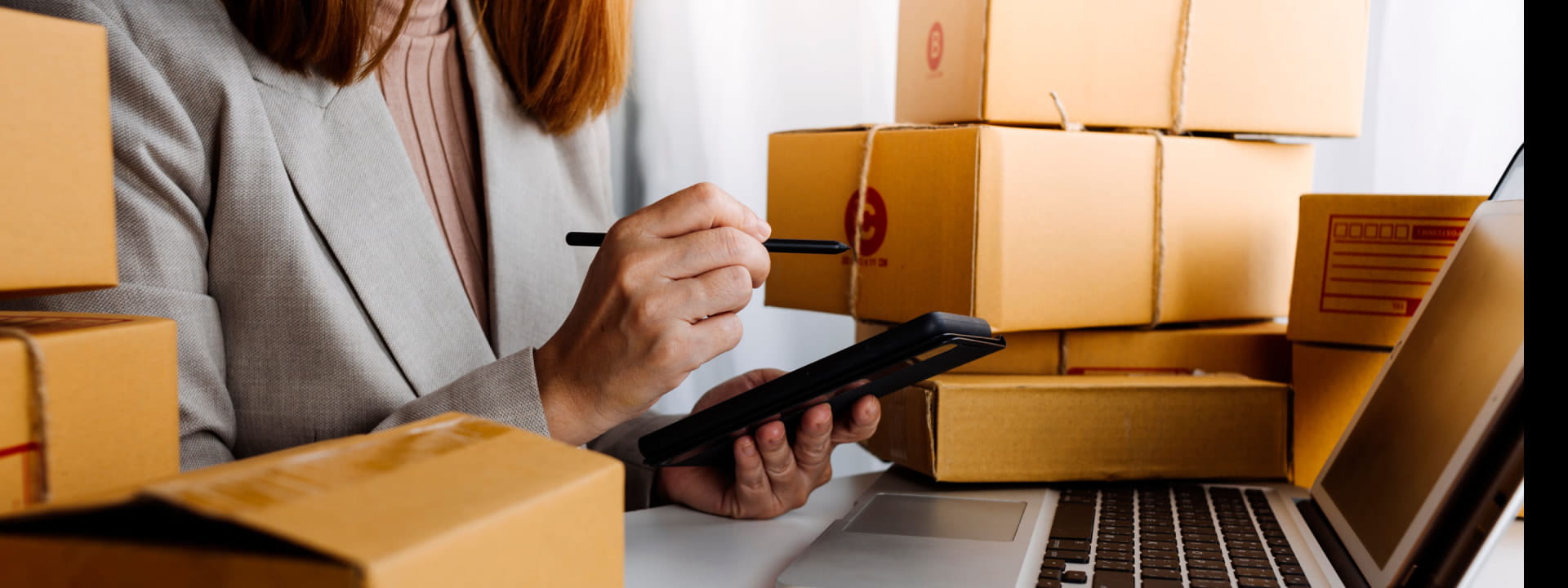What is an eCommerce business and what do they do?

Whether you're a consumer or a business owner, the continued rise of eCommerce is reshaping how Australians engage in commerce. From established enterprises expanding their digital presence to startups launching exclusively online, eCommerce offers a dynamic landscape of opportunity.
eCommerce, short for electronic commerce, refers to all transactions conducted over the internet—whether by individuals or companies buying and selling goods or services. As a result, it's become a vital part of the global and local economy.
From purchasing clothes to booking holidays, eCommerce provides customers with a convenient and efficient way to complete transactions online. For businesses, it’s a powerful sales channel that aligns with evolving consumer habits. In fact, Australia’s B2C eCommerce market was valued at approximately AUD 104 billion in 2024, with forecasts predicting a compound annual growth rate (CAGR) of 7.87% from 2025 to 2033.
The 2024 Australia Post eCommerce Industry Report reveals Australians spent a record AUD 69 billion online in 2024, representing a 12% year-on-year increase. More than 9.8 million households shopped online, with online marketplaces alone accounting for AUD 16 billion of that spend.
What does an eCommerce business do?
An eCommerce business operates as a digital storefront, enabling customers to purchase products or services online. From large retailers to small businesses offering handmade goods, the possibilities are vast. With the convenience of shopping from home and the ability to reach customers globally, it’s no surprise that eCommerce continues to be a popular choice for entrepreneurs.
According to Pattern’s 2024 Marketplace Consumer Report, Amazon has now overtaken eBay to become Australia’s top online marketplace, attracting an average of 75.2 million monthly visits, compared to eBay’s 50.9 million. This marks a notable shift in local consumer preferences and further cements Amazon’s influence in the region.
Beyond Amazon and eBay, other top eCommerce platforms in Australia include major retailers like Woolworths, Coles and fast-fashion giant SHEIN. According to Statista, Australia's eCommerce market is projected to reach approximately USD 47.6 billion in 2025, reflecting a compound annual growth rate (CAGR) of 7.7% from 2023 to 2025.
While most Australians shop domestically, international purchasing remains strong. The Australia Post 2025 eCommerce Report notes that around one in five eCommerce participants in Australia buy from overseas. China is the leading source, accounting for 40% of international purchases, followed by the United States (21%), United Kingdom (14%), Hong Kong (6%), and New Zealand (3%).
In terms of how eCommerce businesses operate, they can adopt a range of models depending on their target customers:
-
Business-to-Consumer (B2C) – Selling directly to individual customers.
-
Business-to-Business (B2B) – Providing goods or services to other businesses.
-
Business-to-Business-to-Consumer (B2B2C) – Selling through business partners that then sell to consumers.
-
Business-to-Government (B2G) – Supplying products or services to government agencies.
Understanding which model best suits your offering is essential for long-term success in the eCommerce space. If you're developing a new product or refining an existing one, this guide to creating a product development strategy offers helpful steps to align your offering with market demand.
Where does eCommerce take place?
As mentioned above, the two eCommerce heavyweights in Australia are eBay and Amazon, which operate as e-marketplaces. These large online trading platforms, as well as the myriad of others that operate nationally and overseas, provide a way for businesses to sell products digitally, and usually offer features like inventory management and analytics to help vendors.
For vendors, other benefits of e-marketplaces are that, unlike setting up your own website, there are fewer upfront ongoing costs. There's also the vast global reach of the platforms.
Company websites are also a popular option in the industry. In contrast to an eCommerce platform, which can serve to decrease the brand visibility of individual businesses against peers, a website can be useful to get a business discovered and build a loyal customer base.
As the Australian government point out, if you're a vendor that wants to inform prospective customers about where your operation is located, what services and/or products you have on offer, and to position yourself in the market, then a website is a must.
Social media - either by itself or as part of a mix with other channels - is the other main eCommerce avenue popular in Australia. Here, think mobile apps and trade driven via popular social platforms like Facebook, Instagram and TikTok.
Additionally, there’s the growth of 'social commerce', which refers to the intersection of conventional eCommerce with cutting-edge social media marketing. According to Forbes, this is where companies incorporate elements like user-generated content, influencer content and 'consumer calls to action' to social posts to drive potential traffic to a website or platform where transactions are then completed.
Many companies have also turned to omnichannel retailing, where businesses offer both online and in-store shopping experiences, to make the most of both new- and old-style channels to market. If done effectively, omnichannel retailing can result in companies leveraging multiple channels to improve relationships with customers, create more effective outreach to target markets, and increase share of consumer spend, as per Infomatica.
Benefits of running an eCommerce business
Tapping into eCommerce can provide Australian businesses with a multitude of benefits, some of which you'll uncover in further detail below.
No need for a physical space
As eCommerce allows bricks and mortar businesses to shift online, it can enable organisations to save on costs associated with physical retail. In addition to savings on in-store labour, there's potential cost reductions on things like lease/rent, electricity, phone bills, heating/cooling, displays, physical repairs and building maintenance.
Flexibility for sellers
Physical stores must abide by restrictions on trading times in accordance with local laws and regulations, but that’s not the case in the world of eCommerce, with products and services available around the clock. Hence, irrespective of real-world trading hours - and global time-zones - sellers can offer products and services to prospective buyers 24/7.
Convenience for buyers
With growing workloads and a faster pace of life, it can be difficult for consumers to get in-store to locate, and then purchase, products and services. In this context, eCommerce is ideal as it enables customers to browse and make purchases at a time that suits them. Most eCommerce sites and platforms give customers all the relevant product details, warranty information, reviews, and descriptions to make a purchase at any time.
Limitless reach
The reality is that a bricks and mortar seller can only reach a certain number of buyers. eCommerce is a gamechanger, allowing retailers to expand their reach across national and international borders. Helpfully, several eCommerce marketplaces have developed their own logistics and delivery systems, streamlining the process of getting products to buyers.
3 challenges for eCommerce businesses
Businesses entering the eCommerce market should also be aware of challenges involved. Here are three of the most common challenges facing the industry:
1. Shipping costs
eCommerce generally involves a significant amount of delivery, so shipping costs can be high. This is something that vendors need to keep a close eye on because if a business sells low-value products, shipping costs can end up being even higher than the product cost.
2. Customer relations
Given vendors interact with consumers online, it can be tricky to develop strong customer relationships as there’s a lack of face-to-face interaction. That's why, as per experts polled by Business News Daily, winning eCommerce means making extra effort on customer service, as well as on pricing, product offerings and loyalty programs.
3. Cybersecurity
Online vendors need to keep a watchful eye out for cybercrime. Business owners need the proper cybersecurity framework to keep customer data safe. Measures such as data security software and tight access control for staff can help keep defences high. For sellers, it can also help to ensure that sites outline the company's privacy and security protection to create a feeling of customer safety.
Tips for eCommerce success
While eCommerce is set for big growth in the months and years ahead, businesses can only expect to see great results if they get their online approach right.
Real-life service
While eCommerce is undoubtedly all about online, following up e-service with great real-life service will help to impress customers. Remember, the growth in online reviews make it super easy for customers to spread the word on the internet if they have a negative experience with a business, which can quickly lead to reputation damage.
Customer confidence
It can be unsettling for customers when a company website provides few, if any, contact details, or business information. Providing information about a company - where it's based, how to contact the customer service team, and what to do if there's a problem with things like shipping - increases customer confidence.
Legal compliance
Setting up as an eCommerce business is fairly straightforward. But remember, e-business transactions are no different to traditional transactions when it comes to the law. Hence, make sure to comply with, legal obligations on things like fair trading, privacy, spam, IP and copyright.
Internet speed
As LinkedIn points out "slow websites kill sales". According to the professional networking site, a delay of one second in a website loading can reduce conversions by 7%, with a three-second delay resulting in a "massive impact on revenue". The takeaway here is that eCommerce vendors should make sure they have a fast and reliable internet service.
Tools and equipment
Making sure you have the right tools and equipment to support your burgeoning eCommerce business is vital - for instance, a printer from Brother’s INKvestment range can help business owners print notes and send files like invoices with ease.
Furthermore, Brother's selection of labellers can also help streamline busy eCommerce operations. Whether it's labelling packages or organising stock, a desktop label printer can produce durable and customisable labels that can make brands stand out. This includes shipping labels, barcodes, graphics, logos, and more.
What does the future of eCommerce look like in Australia?
Australia is currently the 11th largest eCommerce market in the world, and the outlook continues to be positive. According to Statista, the Australian eCommerce market is projected to reach approximately USD 47.6 billion in 2025, with a compound annual growth rate (CAGR) of 7.7% expected through to 2029.
Compared to traditional retail, which continues to grow at a slower pace, eCommerce is steadily capturing a larger share of the market. The Australia Post eCommerce Industry Report 2025 forecasts that one in every three retail dollars will be spent online by 2033 - up from 9% of total retail trade in 2024.
This growth is largely driven by shifting customer expectations. As consumers become more digitally connected and time-conscious, demand for convenience, speed, and seamless service is pushing eCommerce businesses to evolve.
One major contributing factor is changing lifestyles. As Australians increasingly favour high-density living due to housing pressures, there will be growing demand for 24/7 delivery solutions and more streamlined eCommerce logistics (Australia Post). The report also notes a rise in the average value of deliveries, highlighting a broader shift towards online shopping for higher-value purchases.
Sustainability is another critical trend shaping the future. More shoppers are expected to opt for environmentally friendly delivery options, even if it means waiting longer or paying more. This shift reflects the increasing importance of ethical and sustainable business practices within the eCommerce space.
With these trends in mind, now is the time for businesses, large or small, to prepare for what’s next in online retail. Understanding these evolving behaviours and preferences can give brands a competitive edge in a rapidly shifting digital landscape.
eCommerce store setup: Brother's solutions for eCommerce business owners
Starting an eCommerce business or opting to trade online can be an exciting but daunting prospect, especially when it comes to managing customers, invoicing, and shipping. Luckily, Brother has a range of solutions to make these tasks easier for both new and established businesses.
Whether you're just starting your selling journey online or looking to expand your current operations, Brother's high-quality print, scan and label products can help streamline your operations and keep your customers happy. You can trust Brother to provide the support and expertise you need to succeed in the competitive world of eCommerce. Contact us today.

Resource Library
Be the first to receive exclusive offers and the latest news on our products and services directly in your inbox








.jpg?h=720&iar=0&w=1920&rev=36358aeeea934b07bce65a5d230d3519)

